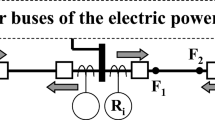Abstract
Flexible AC transmission system (FACTS) devices are gaining popularity in electrical transmission networks for the last few years due to their ability to improve a system’s performance without restructuring or expanding the existing network. But, placing the FACTS device at any arbitrary location in the network may not be optimally beneficial. Also, judging the optimally beneficial location of these devices becomes necessary prior to investment owing to their high expense of installation and maintenance. In this paper, a novel hybrid algorithm combining Cuckoo Search Algorithm (CSA) and Chemical Reaction Optimization (CRO) is proposed to solve the problem of optimally allocating a static VAR compensator (SVC) for the standard IEEE 14-bus, 30-bus and 57-bus transmission systems under heavily loaded condition. The optimal allocation of SVC is done by considering technical aspects like voltage stability, power generation minimization and line loss reduction and also by considering commercial facets like savings on annual cost of power generation and return-on-investment (ROI) time period for the expenditure incurred on the SVC. The ROI calculation is a novel addition to the problem formulation which adds a practical outlook to the feasibility of investment. Thus, a holistic approach is followed for determining the optimal location of the SVC in the power network and the results validate the superior performance of the proposed algorithm.
























Similar content being viewed by others
Abbreviations
- N :
-
Total number of buses
- \(Q_i \) :
-
Reactive power at the bus ‘i’
- \(V_k \) :
-
Voltage at the bus ‘k’
- \(B_{ik} \) :
-
Susceptance between buses ‘i’ and ‘k’
- \(\delta _i \) :
-
Load angle in degrees at bus ‘i’
- \(P_g \) :
-
Generated active power within \(P_g ^{\min }\) and \(P_g ^{\max }\)
- \(Q_p^{SVC} \) :
-
Reactive power injection by SVC at bus ‘p’
- \(B_p^{SVC} \) :
-
Susceptance of SVC at bus ‘p’
- \(P_{D_i } \) :
-
Active power demand at bus ‘i’
- \(Q_{G_i } \) :
-
Generated reactive power at bus ‘i’ within \(Q_{G_i } ^{\min }\) and \(Q_{G_i } ^{\max }\)
- \(Y_{ij} \) :
-
Y-bus admittance matrix between buses ‘i’ and ‘j’
- \(Q_{SVC} \) :
-
Reactive power consumed by SVC within \(Q_{SVC}^{\min }\) and \(Q_{SVC}^{\max }\)
- \(S_{Li} \) :
-
Complex power flow from/to bus ‘i’ within \(S_{Li}^{\max }\)
- \(N_G \) :
-
Total number of generators
- \(N_{TL} \) :
-
Number of transmission lines
- \(C_p \) :
-
Cost of active power generation (in $/h)
- \(a_m ,b_m ,c_m \) :
-
Cost coefficients of generator at ‘m’ generator bus
- \(C_T \) :
-
Total cost of power generation (in $/h)
- \(C_{mnt}\) :
-
Cost of SVC maintenance (in $)
- EMI:
-
Equated monthly instalment
- \(\tau \) :
-
Recovery time
- \(Q_{L_k } \) :
-
Reactive power transmission loss at bus ‘k’
- \(Q_{loss} \) :
-
Total reactive power loss over all buses
- \(C_T^{total} \) :
-
Total cost of active and reactive power generation across all buses
- \(FF_{without\_SVC} \) :
-
Fitness function without SVC in the system
- pe :
-
Potential energy
- ml :
-
Specified molecule
- \(G^{prev}\) :
-
Solution of previous generation
- \(G^{best}\) :
-
Global best solution across all generations
- rand :
-
Random number in specified limits
- \(\Gamma \) :
-
Gamma distribution function
- \(\sigma _x \) :
-
Standard deviation of “x” variables
- g :
-
Specified number of solution
- FACTS:
-
Flexible AC transmission system
- SVC:
-
Static VAR compensator
- SQP:
-
Sequential quadratic programming
- PSO:
-
Particle swarm optimization
- IPSO:
-
Immune particle swarm optimization
- CSA:
-
Cuckoo search algorithm
- TSC:
-
Thyristor switched capacitor
- \(P_i \) :
-
Active Power at the bus ‘i’
- \(V_i \) :
-
Voltage at the bus ‘i’
- \(G_{ik} \) :
-
Conductance between buses ‘i’ and ‘k’
- \(\theta _{ik} \) :
-
Difference in load angle between buses ‘i’ and ‘k’
- \(\delta _k \) :
-
Load angle in degrees at bus ‘k’
- \(Q_g\) :
-
Generated reactive power within \(Q_g ^{\min }\) and \(Q_g ^{\max }\)
- \(V_p \) :
-
Voltage at bus ‘p’ where SVC is connected
- \(P_{G_i } \) :
-
Generated active power at bus ‘i’ within \(P_{G_i } ^{\min }\) and \(P_{G_i } ^{\max }\)
- \(P_{SVC} \) :
-
Active power consumed by SVC
- \(Q_{D_i } \) :
-
Reactive power demand at bus ‘i’
- \(V_{G_i } \) :
-
Voltage at generator bus within \(V_{G_i } ^{\min }\) and \(V_{G_i } ^{\max }\)
- \(T_i \) :
-
Transformer tap at bus ‘i’ within \(T_i ^{\min }\) and \(T_i ^{\max }\)
- \(V_{D_i } \) :
-
Voltage demand at bus ‘i’ within \(V_{D_i } ^{\min }\) and \(V_{D_i } ^{\max }\)
- \(N_T \) :
-
Number of transformers
- \(N_D \) :
-
Number of load buses
- \(C_Q \) :
-
Cost of reactive power generation (in $/h)
- \(\phi \) :
-
Power factor angle
- \(C_{SVC} \) :
-
Cost of SVC installation (in $)
- S :
-
Operating range of the SVC (in MVAr)
- r :
-
Monthly rate of interest
- \(P_{L_k } \) :
-
Active power transmission loss at bus ‘k’
- \(P_{loss} \) :
-
Total active power loss over all buses
- \(FVSI_{sum}\) :
-
Summation of FVSI over all transmission lines
- \(FF_r \) :
-
Fitness function at rth vulnerable bus location
- \(\omega _q \) :
-
Coefficient of preference for criteria where \(0\le \omega _q \le 1\)
- ke :
-
Kinetic energy
- \(G^{new}\) :
-
Created solution
- \(\Delta G^{new}\) :
-
Difference between the current and previous generation
- \(\beta \) :
-
Distribution factor, where \(0.3\le \beta \le 1.99\)
- \(\chi \) :
-
Step size for each generation
- \(G^{dis}\) :
-
Current solution obtained by discovery
- \(\sigma _y \) :
-
Standard deviation of “y” variables
- \(\Delta G^{dis}\) :
-
Difference between current and previous discovered solutions
- OPF:
-
Optimal power flow
- ABC:
-
Artificial bee colony algorithm
- DE:
-
Differential evolution
- IGA:
-
Immune genetic algorithm
- ROI:
-
Return on investment
- CRO:
-
Chemical reaction optimization
- TCR:
-
Thyristor controlled reactor
References
Kothari, D.P., Nagrath, I.J.: Modern power system analysis, Tata McGraw Hill, 4e (2011)
Hingorani, N.G., Gyugyi, L.: Understanding FACTS Concepts and Technology of Flexible AC Transmission Systems, IEEE Press, New York (2000), ISBN 0-7803-3455-8
Frank, S., Rebennack, S.: An introduction to optimal power flow: theory, formulation, and examples. IIE Trans. 48(12) (2016). doi:10.1080/0740817X.2016.1189626
Gotham, D.J., Heydt, G.T.: Power flow control and power flow studies for systems with FACTS devices. IEEE Trans. Power Syst. 13, 60–65 (1998)
Frank, S., et al.: Optimal power flow: a bibliographic survey I Formulations and deterministic methods. Energy Syst. 3, 221–258 (2012). doi:10.1007/s12667-012-0056-y
Frank, S., et al.: Optimal power flow: a bibliographic survey II Non-deterministic and hybrid methods. Energy Syst. 3, 259–289 (2012). doi:10.1007/s12667-012-0057-x
Bhattacharyya, B., Gupta, V.K.: Fuzzy based evolutionary algorithm for reactive power optimization with FACTS devices. Electr. Power Energy Syst. 61, 39–47 (2014)
Duong, T.L,, JianGang, Y., Truong, V.: Application of min cut algorithm for optimal location of FACTS devices considering system loadability and cost of installation. Int. J. Electr. Power Energy Syst. 63, 979–987 (2014)
Duan, C., Fang, W., Jiang, L., Niu, S.: FACTS Devices Allocation via Sparse Optimization. IEEE Trans. Power Syst. 31(2), 1308–1319 (2016)
Jordehi, A.R.: Brainstorm optimisation algorithm (BSOA): An efficient algorithm for finding optimal location and setting of FACTS devices in electric power systems. Electr. Power Energy Syst. 69, 48–57 (2015)
Ghatak, S.R., Acharjee, P.: Optimal allocation of DG using Exponential PSO with Reduced Search Space. In: IEEE International Conference on Computational Intelligence & Communication Technology (CICT), 12–13 February, 2016, ABES Engineering College, Ghaziabad, India
Rezaee, A., Jordehi, et al.: Enhanced leader PSO (ELPSO): A new algorithm for allocating distributed TCSC’s in power systems. Int. J. Electr. Power Energy Syst. 64, 771–784 (2015)
Prasad, D., Mukherjee, V.: A novel symbiotic organisms search algorithm for optimal power flow of power system with FACTS devices. Eng. Sci. Technol. Int. J. (2015). doi:10.1016/j.jestch.2015.06.005
Ghahremani, E., Kamwa, I.: Optimal placement of multiple-type FACTS devices to maximize power system loadability using a generic graphical user interface. IEEE Trans. Power Syst. 28(2), 764–778 (2013)
Ara, A.L., Kazemi, A., Nabavi Niaki, S.A.: Multiobjective optimal location of FACTS shunt-series controllers for power system operation planning. IEEE Trans. Power Deliv. 27(2), 481–490 (2012)
Ghatak, S.R., Basu, D., Acharjee, P.: Voltage profile improvement and loss reduction using optimal allocation of SVC. In: Annual IEEE India Conference (INDICON), New Delhi, pp. 1–6 (2015). doi:10.1109/INDICON.2015.7443350
Sen, D., Acharjee, P.: Hybridization of cuckoo search algorithm and chemical reaction optimization for economic load dispatch problem. In: International conference and exposition on electrical and power engineering (EPE), pp. 798–804. Iasi, Romania (2016)
Parouha, R.P., Das, K.N.: DPD: An intelligent parallel hybrid algorithm for economic load dispatch problems with various practical constraints. Expert Syst. Appl. 63(30), 295–309 (2016)
Gherbi, Y.A., Bouzeboudja, H., Gherbi, F.Z.: The combined economic environmental dispatch using new hybrid meta-heuristic. Energy 115(1), 468–477 (2016)
Mehdinejad, Mehdi, et al.: Solution of optimal reactive power dispatch of power systems using hybrid particle swarm optimization and imperialist competitive algorithms. Int. J. Electr. Power Energy Syst. 83, 104–116 (2016)
Akumalla, S.S., Peddakotla, S., Kuppa, S.R.: A modified cuckoo search algorithm for improving voltage profile and to diminish power losses by locating multi-type FACTS devices. S.R.A. J. Control Autom. Electr. Syst. 27, 93 (2016). doi:10.1007/s40313-015-0219-x
Eslami, M., Shareef, H., Khajehzadeh, M.: Optimal design of damping controllers using a new hybrid artificial bee colony algorithm. Int. J. Electr. Power Energy Syst. 52, 42–54 (2013)
Mahdad, B., Srairi, K.: Optimal location and control of combined SVC-TCSC controller to enhance power system loadability. Int. J. Syst. Assur. Eng. Manag. 5, 427 (2014). doi:10.1007/s13198-013-0184-3
Taher, S.A., Amooshahi, M.K.: New approach for optimal UPFC placement using hybrid immune algorithm in electric power systems. Int. J. Electr. Power Energy Syst. 43(1), 899–909 (2012)
Dutta, S., Roy, P.K., Nandi, D.: Optimal location of UPFC controller in transmission network using hybrid chemical reaction optimization algorithm. Int. J. Electr. Power Energy Syst. 64, 194–211 (2015)
Yang, X.S., Deb, S.: Cuckoo search via L’evy flights. In: Proc. of World Congress on Nature & Biologically Inspired Computing (NaBIC 2009), December 2009, India, pp. 210–214. IEEE Publications, USA (2009)
Lam, A.Y.S., Li, V.O.K.: Chemical-reaction-inspired meta-heuristic for optimization. IEEE Trans. Evol. Comput. 14(3), 381–399 (2010)
Lam, A.Y.S., Li, V.O.K.: Real-coded chemical reaction optimization. IEEE Trans. Evol. Comput. 16(3), 339–353 (2012)
Alabduljabbar, A.A., Milanović, J.V.: Assessment of techno-economic contribution of FACTS devices to power system operation. Electric Power Syst. Res. 80(10), 1247–1255 (2010)
Shaw, B., Mukherjee, V., Ghoshal, S.P.: Solution of optimal power flow with FACTS devices using opposition-based gravitational search algorithm. In: Swarm, evolutionary, and memetic computing, pp. 661–673. Springer International Publishing (2015)
Subramani, C., et al.: Simulation technique for voltage stability analysis and contingency ranking in power systems. Int. J. Recent Trends Eng. 2(5), 263–267 (2009)
https://en.wikipedia.org/wiki/Equated_monthly_installment. Accessed 10 Aug 2017
http://www2.ee.washington.edu/research/pstca/. Accessed 11 Aug 2017
http://www.ece.ubc.ca/~hameda/download_files/. Accessed 1 Aug 2017
Author information
Authors and Affiliations
Corresponding author
Rights and permissions
About this article
Cite this article
Sen, D., Ghatak, S.R. & Acharjee, P. Optimal allocation of static VAR compensator by a hybrid algorithm. Energy Syst 10, 677–719 (2019). https://doi.org/10.1007/s12667-017-0247-7
Received:
Accepted:
Published:
Issue Date:
DOI: https://doi.org/10.1007/s12667-017-0247-7




